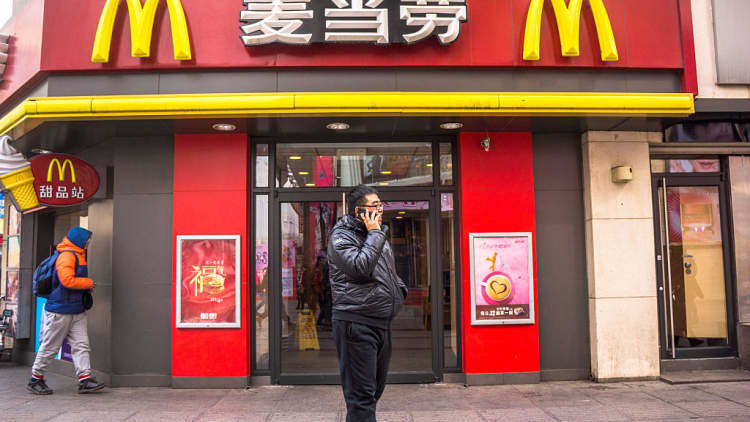McDonald’s Defies Global Business Exodus From China, Bets Big As Other Giants Navigate Shifting Sands in China
In a bold departure from the prevailing trend of multinational corporations cautiously reducing their exposure to China amid geopolitical uncertainties, McDonald's has recently taken a decisive step to deepen its engagement in the Chinese market. The strategic move involves reclaiming a significant stake in its China business, a notable contrast to the derisking maneuvers witnessed across various Western firms. While such a decision may seem counterintuitive given the challenges posed by a consumer slowdown and geopolitical tensions, analysts contend that the potential rewards for McDonald's could be substantial.

McDonald’s is defying the prevailing trend among Western companies, opting to increase its stake in the Chinese market despite challenges like a consumer slowdown and geopolitical tensions.
Analysts acknowledge the apparent risk but emphasize the potentially significant rewards. In a recent move, McDonald’s repurchased the 28% stake in its China business previously held by Carlyle Group, now securing a 48% share in operations valued at $6 billion, including those in Hong Kong and Macau.
McDonald’s strategic move, unlike some of its counterparts, is bolstered by its majority partner in the Chinese business, CITIC, a powerful Chinese state-owned conglomerate providing substantial political cover.
According to Jason Yu, the managing director of market research firm Kantar Worldpanel in Greater China, having such a partner positions McDonald’s away from the forefront of geopolitical tensions and offers a crucial advantage.
While Starbucks, Apple, Tapestry (owner of Coach), and Nike also remain committed to the Chinese market, they face increased competition and are adapting strategies to protect and expand their market share- for instance, Starbucks is expanding with smaller cup sizes, and Nike is offering localized, higher-end sneakers.

McDonald’s, fueled by funds from the Carlyle investment, has doubled its restaurant count in China since 2017, making it the second-largest market for the company. The goal is to exceed 10,000 stores in China by 2028.
Competitors such as Yum China, operating KFC and Pizza Hut, and domestic players like Wallace and Tastien are also expanding their presence in China’s competitive market.
While optimism about McDonald’s prospects in China is high, concerns linger about the potential fallout if relations between China and the West deteriorate.
Greg Halter, Director of Research at Carnegie Investment Counsel, warns that companies, including McDonald’s, might divest their Chinese operations, similar to recent occurrences in Russia, if tensions worsen.
Experts suggest further digitalization and localization to navigate China’s $140.2 billion limited-service restaurant sector successfully; McDonald’s has already incorporated local flavours into its menu, such as the taro pie, catering to the unique tastes of Chinese consumers.
Although the limited-service restaurant market in China faces challenges from slowing economic growth and subdued consumer spending, McDonald’s is well-positioned to outperform, benefiting from value-driven middle-class consumers and lower commercial rents nationwide.
Famous Brands That Have Quit China
Major multinational corporations are increasingly disengaging from China amid a backdrop of persistent challenges in Sino-global relations.
The ongoing US-China trade war, coupled with tensions over Taiwan and many other contentious issues, including intellectual property theft, human rights violations in Xinjiang, and the diminishing autonomy of Hong Kong, has prompted several renowned companies to exit the Chinese market.
1. Dell Technologies.
As tensions escalated, Dell discreetly redirected its production and supply chains away from China; initial reports in 2019 indicated the Texas-headquartered tech giant’s plan to relocate up to 30% of its notebook production out of China.
In January of the current year, Dell reaffirmed its commitment to this shift by announcing the phasing out of China-made chips and instructing suppliers to reduce the provision of Chinese components.
This decision aligned with the broader geopolitical landscape, where the Biden administration imposed controls limiting the export of US semiconductor chips to China and blacklisted Chinese chipmaker YMTC along with 21 “major” AI companies.
Dell stated its ongoing exploration of global supply-chain diversification to align with customer needs and business interests.
2. HP
Dell’s competitor, HP, is also reportedly considering relocating 30% of its notebook production away from China, a move aligned with Dell’s strategy.
HP sold its Chinese laser printer production operation to Taiwanese company Foxconn in 2021; moreover, HP initiated assessments with suppliers to explore the feasibility of moving its production and assembly operations away from China.
3. Blizzard Entertainment
In January of this year, Blizzard, renowned for blockbuster video games like World of Warcraft, officially severed ties with China, terminating its agreement with Chinese tech company NetEase.
The failure to reach a mutually acceptable deal, consistent with Blizzard’s operating principles, resulted in a significant setback; the move had repercussions for NetEase, China’s second-largest gaming company, with shares plunging approximately 11% following the announcement.
However, despite attempts by Blizzard to extend the contract, popular games available in China since 2008 were removed from servers when the deal expired on January 23.

4. Stanley Black & Decker,
Prominent industrial tools and household hardware manufacturer, Stanley Black & Decker also joined the exodus – in November 2021, after 25 years of operation, the company permanently shuttered its factory in Shenzhen, citing intensifying competition and escalating labor and land costs as primary factors.
In a strategic shift, Stanley Black & Decker inaugurated a state-of-the-art, $90 million facility spanning 425,000 square feet in Fort Worth, Texas, in 2021.
5. Nike
Another significant player under the lens of the strained US-China relationship is Sportswear giant Nike, which has witnessed a shift in its supply chain dynamics, with its suppliers relocating production facilities to Southeast Asia and Africa.
The company responded to concerns about alleged mistreatment of Muslim Uyghurs in Xinjiang by reviewing its supply chains in the region; the scrutiny resulted in a boycott by swathes of Chinese consumers, impacting Nike’s sales in the country alongside challenges posed by COVID lockdowns.
6. Hasbro
American toy and board game manufacturer Hasbro has been steadily moving a significant portion of its production out of China, diversifying to factories in Vietnam and India.
The company aimed to reduce the volume of goods produced in China for the American market to 50% by the end of 2020, down from just under two-thirds in 2019.
7. Intel
Intel, while maintaining confidence in the Chinese economy, has, like many US companies, shifted the manufacturing and assembly of some products to Vietnam.
Former CEO Bob Swan and current CEO Pat Gelsinger emphasized the need for a national manufacturing strategy to ensure fair competition, especially in response to China’s anticipated dominance in the semiconductor chip production industry.
8. Samsung
Samsung Electronics, a major player in the tech industry, has withdrawn from China, investing $230 billion in building five chip factories across South Korea.
The company ceased smartphone production in China in 2019 and closed its last Chinese PC plant in August 2022, redirecting operations to Vietnam.
Samsung has also focused on chip manufacturing within the US, aligning with the US CHIPS and Science Act, which discourages expanding chip operations in China for the next decade.
9. LG Electronics
Fellow South Korean firm LG Electronics has followed Samsung’s lead, relocating manufacturing of some products from China to avoid US tariffs; LG shifted all production of refrigerators bound for the American market from China’s Zhejiang Province to South Korea.
10. Puma
Puma, facing the aftermath of a Chinese consumer boycott sparked by statements on Uyghur Muslims, is diversifying its manufacturing base and supply chains.
Unlike Adidas, which has halved its Chinese manufacturing since 2010, Puma is producing more of its running shoes, sportswear, and other products in countries like Bangladesh, Cambodia, Indonesia, and Vietnam, aiming to mitigate the impact of the boycott and navigate US tariffs.

11. Airbnb,
Global accommodation giant, Airbnb, ceased all Chinese listings during the height of COVID-19 lockdowns, signaling its withdrawal from a domestic market it entered in 2016; while maintaining an office in China to assist Chinese tourists in booking accommodations worldwide, Airbnb has shifted its focus away from the turbulent Chinese tourism market.
12. Sharp
Japanese consumer electronics company Sharp is among the 87 firms benefiting from the Japanese government’s initiative to incentivize domestic companies to shift production away from China.
Sharp, which is majority-owned by Taiwan’s Foxconn, with an allocation of 243.5 billion yen, is part of this broader effort to reduce reliance on China.
13. Alphabet
Google’s parent company, Alphabet, has experienced disruptions in its supply chains, prompting a move of manufacturing for its flagship Pixel smartphone to Vietnam and production for various smart home products is reportedly transitioning to Thailand instead of China.
This shift is part of a more extended process to diversify production locations and reduce dependency on Chinese manufacturing.
14.LinkedIn
LinkedIn, now owned by Microsoft, closed its Chinese site, citing a challenging operating environment and increased compliance requirements. The platform faced criticism for blocking the profiles of some journalists, leading to the launch of a jobs-only version called InCareer in December 2021.
15. Sony
Sony closed its smartphone plant in Beijing in 2019, relocating production to Thailand due to disappointing sales and rising costs in China; the company also moved its regional executives from Hong Kong to Singapore in July 2020.
16.BlackRock,
BlackRock prominent New York investment bank, initially planned to become a major player in the Chinese market but indefinitely postponed the launch of its exchange-traded fund (ETF) in China in November 2022.
The decision was attributed to US-China tensions, the risk of political backlash, and higher returns from US treasury bonds compared to Chinese bonds.
17. Fashion companies like Steve Madden, Old Navy (a Gap sub-brand), and Superdry have decided to shift production away from China due to factors such as tariffs, lackluster sales, and strategic reviews. Steve Madden planned to relocate production to countries like Cambodia, Brazil, Mexico, and Vietnam.
18. The New York Times moved part of its Hong Kong office to Seoul, South Korea, in response to Beijing’s controversial security law, which curtailed freedom of speech in the Special Administrative Region. The law raised concerns about Hong Kong’s prospects as a hub for journalism.
19. Dentons, the world’s largest law firm by the number of employees, separated from its Chinese arm, operating as a standalone business named Dacheng; the decision was driven by new mandates and requirements related to data privacy, cybersecurity, capital control, and governance.
20. Taiwan’s Quanta Computer, a major electronics manufacturing services company, shifted some of its manufacturing from China to a new $500 million plant in Taiwan’s municipality of Taoyuan in 2019; the move aimed to diversify production locations and reduce dependence on Chinese manufacturing.




